| Please access the following URL if you want to secure using SSL. All pages in the site will be secure pages. |
https://secure02.blue.shared-server.net/www.fish-food.co.jp/message english 5.2022.html |
Welcome to FISH FOOD TIMES
May. 2022 issue No.221

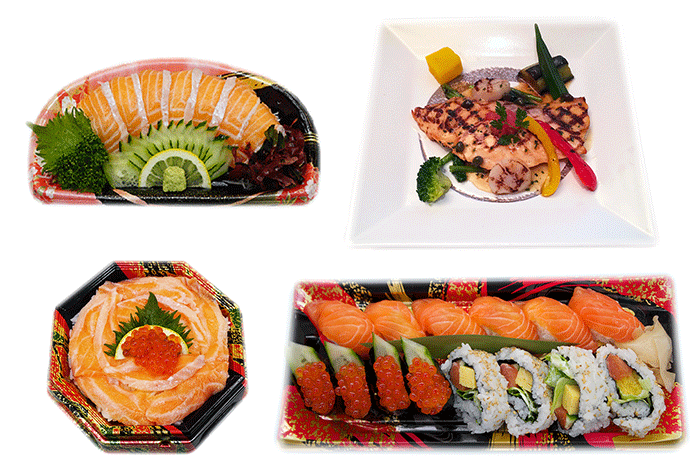
War and fish
Impact of war on fishery prices
As you know, "War and Peace" is a feature -length novel written by Russian writer Tolstoy in the early 19th century. Russian enemies, 200 years ago, where the novel was set, changed from France to Ukraine, and the war began, and the global economy is upset.
Norwegian airlift salmon was immediately affected by the war, and the price was immediately affected. The aircraft carrying salmon could not fly over Russia, and the imported amount of air transportation on major routes used so far has been significantly reduced. Nowadays, the distribution price in Japan has risen by 30-50 % since the war, and it is surprising that 3,000 yen/kg is not unusual for trim C at the store's store purchase price.
Not only raw atlantic salmon, but as of March 20, 2022, the salmon and trout prices of the Tokyo wholesale market, which were aggregated by the Fisheries Agency, are rising in general.
The most recent good news was that Japanese and Russian fisheries negotiations on salmon and trout, born in the Russian river, were concluded on April 23. The catch of Salmon and Trout in 2022 in Japan's exclusive economic water (EEZ) around Hokkaido was determined at 2,050 tons. Fishermen paying for Russia in accordance with the catch is also decided in the same level of 200 to 300 million yen, which is the same as the previous year.
The Japanese government has blocked Russia as in Europe and the United States. On the other hand, I can not guess how Russia will counter Japan in the future, and I do not know how much this will have a significant impact on the price of fisheries imports. After all, the parts that Japanese fisheries imports depends on Russia is very large. By country, Russia is the third place after China and Chile.
The following table is a marine product for each item announced by the Ministry of Agriculture, Forestry and Fisheries as an overview of the import / export information and distribution. Among them, the writer selected an item that Russia was ranked third or more in the world ranking, and edited it.
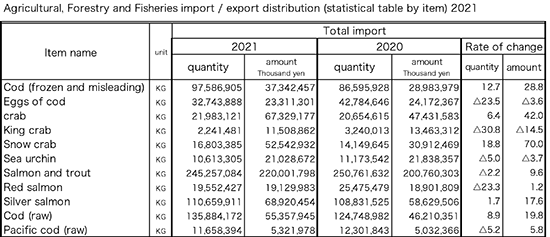
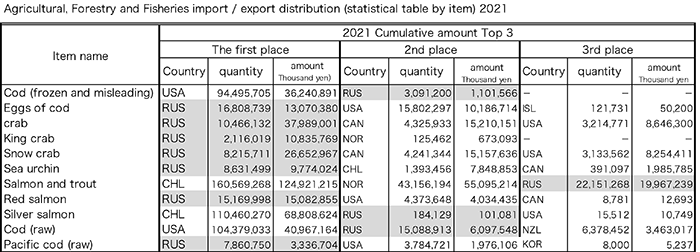
As a fisheries product that can be infected from the table above, the whole fisheries made from COD Surimi will be greatly affected. Next, it is unknown how much the price of Mentaiko and Tarako using alaska pollack fish eggs will rise.Furthermore, I think that the price of king crab and snow crab, which have been rising one after another for several years and have already become untouchable, will inevitably rise further, but according to some information, the price of the United States It is said that the price has dropped due to the stoppage of imports, but what is the truth and what will happen in the future? Chile sea urchin has a strong presence, but Russian sea urchins are overwhelmingly imported as Chile sea urchin. In addition, the sea urchin in Hokkaido must not overlook the aspect that is established due to the existence of Russian sea urchin ingredients.
In this table, Russia is the third place after Chile and Norway, especially in the table, but this is the contrary of Chile and Norwegian aquaculture salmon, and Russia and the United States are almost 100 % natural salmon. If you take only natural salmon data, Russia will jump to the first place.
How to respond to double punches with weak yen at exchange rates
As of April 28 (Thursday), the exchange rate is 130.51 yen to the dollar. Just one year ago, it was 108.5 yen on the same day, so the value of the yen has dropped by about 20% in a year. Even if it is the same imported product, it is necessary to pay extra money compared to a year ago. If the BOJ's interest rate policy does not change significantly in the future, 150 yen to the dollar will not be unthinkable. If one dollar is 150 yen, even a fishery product of the same standard purchased a year ago will not be available unless you spend about 40% more money by simple calculation.
This is just a matter of exchanging money, which has nothing to do with the market price of fishery products, and what will happen if the market price rises due to the above-mentioned environmental changes are added to this? An unimaginable world awaits us, which cannot be inferred by conventional wisdom.
The Norwegian airlift salmon has already risen by nearly 50% compared to before, and the trim C has exceeded 3,000 yen / kg, as mentioned above. As long as we are in such a double-punch environment, it seems that this will rise to 3,500 yen / kg in the future, and fishery retailers must anticipate such a situation.
In the following, let us consider the points to note when commercializing raw salmon salmon airlifted from Norway after May.
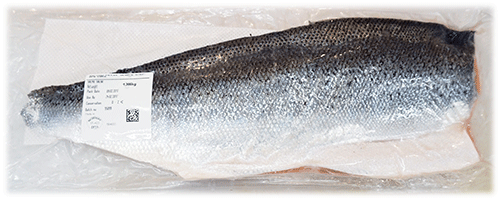
This image is in a trim C vacuum bag of Norwegian airlift Atlan salmon. Assuming that the yield rate of this product is 85%, if the purchase price is 3,500 yen / kg, the yield cost will be 4,118 yen / kg, so the cost per 100g will be about 415 yen. If you sell this at tanzaku and secure a markup ratio of about 30% to 35%, the selling price will have to be set to 598 yen to 638 yen / 100g. From a field perspective, I think this is a feeling that the selling price up to now will be replaced by the cost.
Therefore, let's try the following as a polite method so as not to reduce the value of raw Atlan salmon trim C, which becomes expensive and cannot be handled easily.
| Raw atlan salmon tanzaku commercialization work process |
|---|
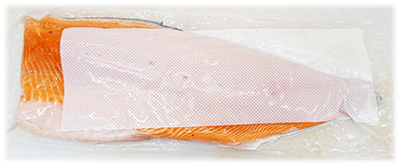 |
| 1,This vacuum-packed raw Atlan Salmon Trim C had a best-by date of two weeks after it was manufactured in Norway. However, it is safer to avoid storing until the deadline, and it is important not to rely on the vacuum method so much and to use up as soon as possible without producing an unpleasant odor. |
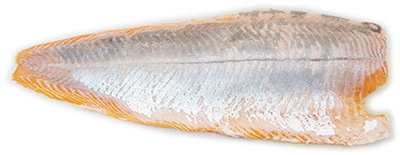 |
| 2,When you peel the skin, thick subcutaneous fat appears, but depending on how you handle this subcutaneous fat and the chiai meat of fish that exists underneath, your likes and dislikes of raw salmon will be greatly divided. |
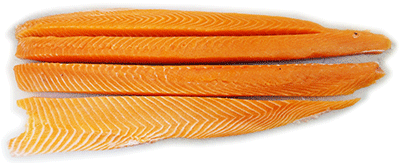 |
| 3,Since this fish weighs about 1.4 kg in half, I split the back and belly into two without hesitation, but the toro part of the belly will be further split vertically. |
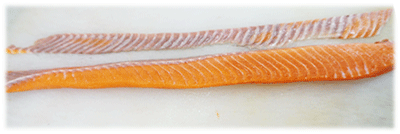 |
| 4,This is an important task when dealing with raw salmon, which I especially recommend. It is to scrape off the brown chiai meat part with a kitchen knife, apart from the skin part where the subcutaneous fat of the part corresponding to the abdominal body toro is white. If you buy raw salmon sashimi or sushi and happen to eat the brown part of this, some people will hate salmon because of this. The same thing can be said for those who dislike Katsuotataki(Seared Bonito), but the treatment of chiai meat, which has a strong fishy odor, can have a negative effect on taste evaluation. |
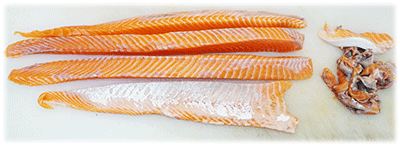 |
| 5,At the right end of the above image is the chiai meat part that has been scraped off, which can reduce the yield rate to about 82%. Therefore, if you reduce the amount of scraping, it may be 88%, and I think that this method should be calculated with a yield rate of about 85% on average. |
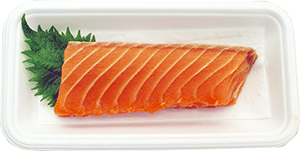 |
| Raw salmon for sashimi tanzaku |
Next is the treatment of raw salmon belly. In order to increase the added value of raw salmon and secure profits, it will make a big difference depending on how the belly body part is commercialized. The reason is that the belly of raw salmon does not have the risk of cracking like the bellows part of bluefin tuna ootoro, and it is elastic but firm, and it can be cut thinly and widely to around 6 to 7 g. I can. For this reason, it is possible to raise the markup ratio because the value can be appealed and marketed as a special part on which the fat of raw salmon Toro is placed.
| Various commercialization of raw salmon belly body |
|---|
 |
| Raw salmon belly body |
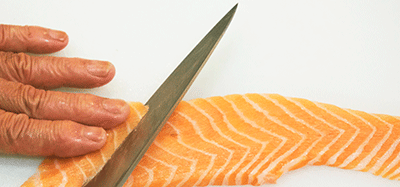 |
| Basically, with the white skin down, slice it into thin slices of around 6g using the sogitsukuri sashimi technique. |
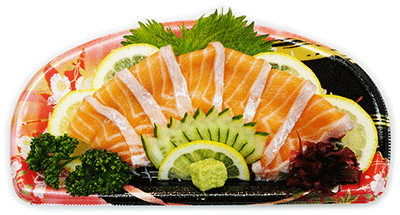 |
| Raw salmon toro sogitsukuri sashimi |
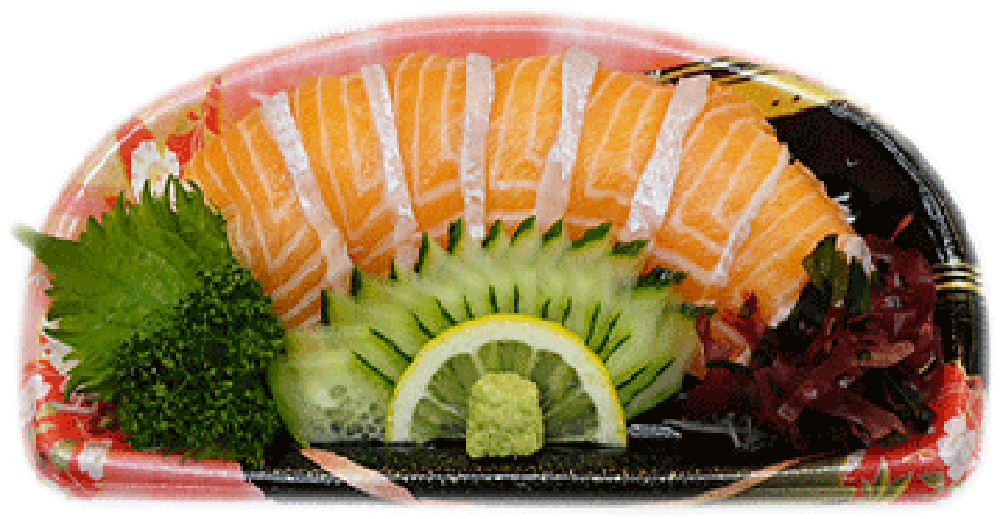 |
| Raw salmon toro sogitsukuri sashimi(Bavarian-style arrangement) |
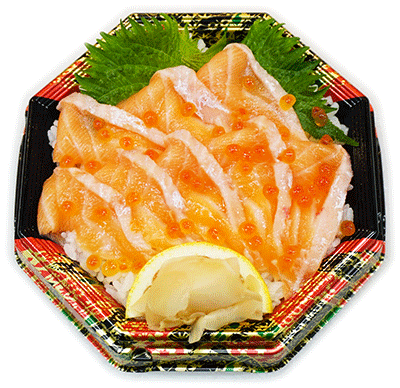 |
A.Oyakodon with raw salmon toro |
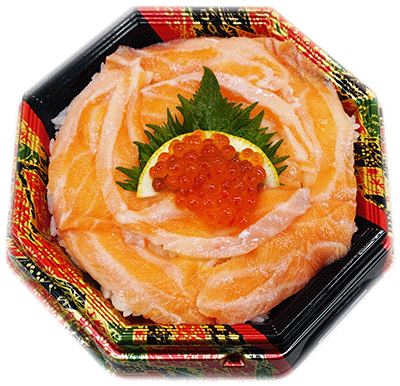 |
| B.Raw salmon toro ikura plenty oyakodon |
Raw salmon toro sogitsukuri sashimi costs 166 to 208 yen in total assuming that 40g to 50g of ingredients are used, and if you add 50 yen to the sashimi and material costs, you can calculate that the product cost will be 216 to 258 yen. For this reason, the selling price should be set between 450 yen and 500 yen. The second raw salmon toro sogitsukuri sashimi (Bavarian-style arrangement) has almost the same cost, and you can think of it as a difference in how to arrange it.
A of oyakodon of raw salmon toro is 208 yen to 249 yen when using 50 to 60 g of 8 slices of raw salmon. Furthermore, if ikura costs 100 yen for 10g and 200g of sushi rice that costs 50 yen for 100g is used, this is an additional 100 yen, and if ashirai and material costs are added by 50 yen, the product cost will be 458 yen to 499 yen. I think this will be a selling price of 780 yen to 880 yen, so it will be a fairly high price for donburi.
Next, for Oyakodon B of raw salmon toro, it is sufficient to calculate that 2 pieces of fillet and 10g of ikura will increase, so a total of about 150 yen will be added, and the product cost will be 608 yen to 649 yen. In this case, the selling price will be 1,000 to 1,080 yen, which makes you feel that it is quite high for a donburi.
Furthermore, when it comes to assorted full raw salmon sushi as shown in the image below, ikura uses 40g for 400 yen, nigiri sushi sushidane uses 72g for 6kan of 12g, and about 15g of raw salmon wrapped in back-rolled salmon. .. With these, the total cost is 362 yen, and if you add about 300g of sushi rice to 150 yen, and ahirai and material costs and other costs of 100 yen, the cost will exceed 1,000 yen. Then, it can be estimated that the selling price will be around 1,800 yen.
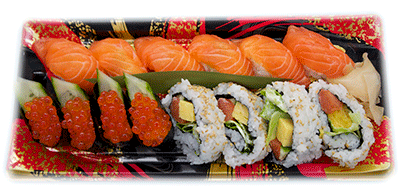
The ikura used for the sushi product in the above image is Autumn salmon's akiko, and it is assumed that it will be purchased at 10,000 yen / kg. The cost can be changed cheaply by changing the grade of ikura to beniko or masuko. However, if we repeat these easy decisions, we must be prepared to fall into the trade-off muddyness mentioned in last month's issue, which is to "deceive with cheap substitutes."
Delicious raw salmon fillet
Next, I should mention the salmon fillet. In Japan, salt salmon has a history of being eaten as one of the national dishes, and I think it is safe to say that salt salmon is still one of the representative fish fillets. However, it is not true that raw Atlantic salmon is such a casual national dish, and it has been treated as a special high-class salmon that is basically used as a material for sashimi and sushi from the beginning of its introduction. After all, until the advent of airlifted raw salmon, salmon sashimi was eaten in frozen ruibe in Japan, so raw salmon was not eaten as sashimi or sushi. The emergence of raw salmon by air was there, and it began to be eaten in the form of sashimi and sushi, so in a sense it was a major change in the history of fish eating in Japan.
Since airlift raw salmon is originally in that position, it is a high-class fish in the first place. When it comes to eating the high-class raw salmon, it is self-evident that the price will be high, and it is the raw salmon that cannot be easily handled with 100 yen per slice of salted salmon fillet.
For example, when it comes to cooking with raw Atlantic salmon fillets, the a delicious taste seems to be plump and juicy. If you slice the fillet into thin slices to reduce the selling price of raw Atlantic salmon, you cannot enjoy its goodness. In order to taste a steak-like dish using raw salmon served at a restaurant, the weight of raw salmon fillet should be at least 150g, preferably 200g or more. In this way, it can be the protagonist of the supper.
In the image below, the top is a raw atlan salmon fillet without skin, and the bottom is a raw atlan salmon fillet with skin, each of which is cut to about 200 g and commercialized.
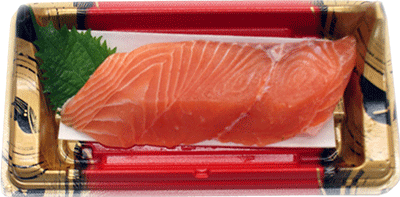
a raw atlan salmon fillet without skin 200g
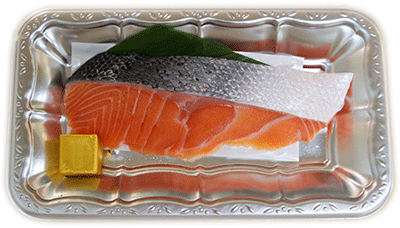
a raw atlan salmon fillet with skin 200g
Assuming that the yield rate with skin is 97% and the yield rate without skin is 93% when raw Atlan Salmon Trim C is used as a fillet, the purchase price of 3,500 yen / kg is 3,610 yen / kg and 3,764 yen / kg, respectively. The cost of each is roughly 751 yen without skin plus about 771 yen for material cost 20 yen, and 722 yen with skin plus 752 yen for material cost 30 yen. Then, the selling price is expected to be around 1,300 yen without skin and around 1,200 yen with skin.
If you see a fillet with such a selling price in a store, most people may blame you for selling raw salmon fillets with such an unconventional selling price.
However, since the market price of raw atlan salmon is in such a situation, the standard calculated and derived is such a selling price. If we cut the markup ratio to about 20% and make it 950 yen with skin and 1,000 yen without skin, how much difference will it make in sales? I don't think the number of sales will be much different.
When a big change in the environment is happening like now, I think that it is the ironclad rule of business to adjust myself so that I can adapt well to the changed environment, instead of moving wisely. A product that is clearly not easy to sell should be sold with a high value that can be appealed to the few customers who understand the value of the product and are satisfied with the selling price.
Raw salmon steak
In the past, fFISH FOOD TIIMES posted the following images in the September 2014 issue No.126 to introduce red salmon steak.
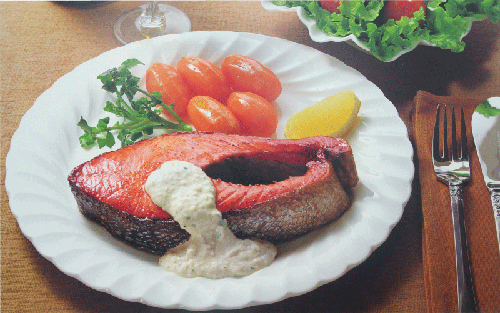
A long time ago, I went to Alaska to buy red salmon in July 1982, 40 years ago when I was a buyer of a company. This image is a copy of the photo used for the sales promotion panel that I commissioned a professional cameraman in October of that year to promote the sockeye salmon that I bought in Alaska at the company I belonged to at that time.
The reason why I decided to create this promotional panel was when I went to Alaska to buy red salmon and received entertainment from the trading company Marubeni, who brokered the import at the restaurant in Anchorage. I was very impressed with the taste of the salmon steak I ate, and I remember that I wanted to spread the same emotional impression in the areas of Fukuoka and Kyushu.
The salmon steak served at the Anchorage restaurant was just like the image. The author told the professional photographer in detail what he had experienced in the field, and at the shooting studio, the chef of the restaurant, the professional photographer, and the author discussed it, and it was shot at many angles and patterns until this image was obtained. I remember spending almost a day.
The red salmon steak used for this shoot was decided by the author to eat as a privilege of the client of this work after the shoot. However, in order to make the dish look good, the surface was oiled with a brush, including not only red salmon but also vegetables. After seeing all the shooting work, I didn't feel like eating very much after shooting.
This image uses a 6/9 size red salmon IQF dress sliced into slices, but what I actually ate at an Anchorage restaurant was like this, but the material was raw king salmon. It's just an American giant, and I think it was probably a pound. As a young man just after the age of 30, I was deeply surprised at the big king salmon steak he saw for the first time and was impressed by its taste.
However, the desire to spread the excitement of this food in Japan did not seem to come to my mind, and the author's desire was never realized. And now, 40 years after that, if salmon steak is widespread in Japan, unfortunately there is no such fact and it must be admitted that only beef steak is supported by people.
From now on, it will be difficult to propose salmon steaks made by slicing red salmon 6/9 size dresses to customers. However, recently, salmon have been cultivated all over the country in Japan, and the time may come when it is not necessary to rely on airlift salmon from Norway.

This image is a salmon steak made from raw Atlan salmon that I ate at a restaurant. I hope that we will be in an era where such salmon steaks can be eaten normally at home. But the key is that domestic salmon farming will be on track and will be self-sufficient rather than airlifted from Norway.
Japan, which has been proud of its fish-eating culture, wants to change the distorted structure of having to rely on foreign imports for its main fish. For that reason, I would like all the people involved in the fishing industry to do their best and support them. Fisheries officials want to cooperate with each other so that they can be economically viable.
| Please access the following URL if you want to secure using SSL. All pages in the site will be secure pages. |
https://secure02.blue.shared-server.net/www.fish-food.co.jp/message english 5.2022.html |
An opinion and the communication are to iinfo@fish food times
Date of updating 1 May. 2022
